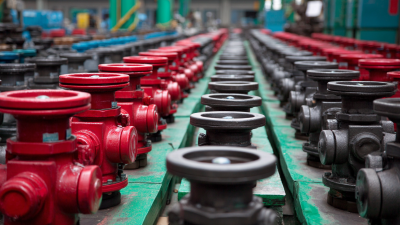
In the pursuit of enhanced production efficiency and cost-effectiveness within various industries, optimizing filtration processes has become paramount. Pressure nutsche filters have emerged as a critical technology designed to improve solid-liquid separation, often cited for their ability to achieve higher throughput rates and superior filtrate quality. According to a recent industry report by Technavio, the global filter market is projected to grow at a CAGR of 5.4% from 2021 to 2025, with pressure nutsche filters playing a pivotal role in this trend due to their versatility in handling diverse applications from pharmaceuticals to chemicals.

With the right operational parameters and maintenance strategies in place, businesses can significantly maximize their filtration efficiency, reduce waste, and enhance their overall productivity. This guide will delve into the essential practices and insights necessary for harnessing the full potential of pressure nutsche filters, ensuring you stay ahead in a competitive landscape.
Pressure Nutsche Filters (PNFs) play a crucial role in optimizing filtration processes across various industries, especially in chemical and pharmaceutical sectors. These filters operate under pressure, allowing for increased filtration rates and improved separation efficiency. According to a report by the Chemical Engineering Journal, utilizing PNFs can enhance solid-liquid separation processes by up to 30%, significantly reducing the time required to achieve desired purity levels.

One of the key benefits of Pressure Nutsche Filters is their ability to handle a wide range of materials, including viscous and high-density slurries. A study published in the Journal of Hazardous Materials highlighted that PNFs not only provide superior retention of fine particles but also minimize the risk of filter blinding, a common issue with traditional filtration methods. This capability ensures consistent product quality and reduces operational downtime, leading to more efficient production workflows.
Moreover, the implementation of PNFs can result in lower energy consumption when compared to conventional batch filtration systems. The Global Institute for Sustainable Process Technology reported that industries employing PNFs could see energy usage decrease by approximately 20%, emphasizing their role in promoting sustainable manufacturing practices. As industries strive to enhance efficiency and sustainability, Pressure Nutsche Filters emerge as a superior choice in modern filtration technology.
Optimizing the filtration process using pressure nutsche filters involves a detailed analysis of key performance metrics to enhance efficiency rates and yield improvements. Recent advancements in filtration technology emphasize the importance of monitoring methods that can assess the performance of various industrial applications. The efficiency of pressure nutsche filters can be significantly increased by implementing systematic frameworks that evaluate not just the filtration rates, but also the overall process effectiveness, including resource utilization and consistency in output.
Moreover, recent literature highlights innovative approaches in process intensification that can greatly benefit filtration systems. By integrating modern extraction techniques and enhancing resource recovery, industries can achieve higher yields from their raw materials, ultimately elevating productivity. Understanding these metrics allows companies to tailor their filtration processes, ensuring they not only meet current demands but also push the boundaries of efficiency and sustainability in industrial applications.
To maximize the performance of pressure nutsche filters in your filtration process, paying attention to pressure settings can significantly enhance flow rates. Just as studies have demonstrated the importance of pressure adjustments in various applications—like those investigating fluid dynamics in nozzle spray or optimizing air mass flow in fuel cells—similar principles apply to your filtration systems. Ensuring that your pressure settings are fine-tuned can lead to improved operational efficiency and product yield.
When setting up your pressure nutsche filters, consider experimenting with different pressure parameters. Research indicates that variations in cathodic pressure can lead to notable shifts in system efficiency. Utilizing analytical methodologies can help quantify the ideal settings for your specific application. Moreover, it’s essential to balance pressure with flow rates, as optimizing these two factors can significantly influence the throughput and quality of the filtered product. By systematically adjusting and measuring the effects of pressure on your filtration process, you can achieve substantial improvements, leading to a more efficient and effective filtration system.
Maintaining high efficiency in the filtration process is crucial for industrial operations, particularly when utilizing pressure nutsche filters. One key aspect of sustaining this efficiency is implementing effective maintenance strategies. Regular inspection and cleaning of the filters play a significant role in minimizing downtime. Establishing a routine schedule for monitoring filter performance helps in identifying potential issues before they escalate, allowing for prompt corrective actions to be taken.
In addition to routine inspections, training personnel on proper handling and maintenance procedures is essential. Employees should be aware of the operational parameters and the importance of adhering to them to prevent unnecessary wear and tear. Utilizing advanced monitoring technologies can also enhance maintenance efforts; for instance, real-time data analytics can provide insights into filter performance, enabling predictive maintenance that reduces unscheduled outages and extends the lifespan of the equipment. By integrating these strategies, businesses can significantly reduce downtime and optimize their filtration processes.

The cost-benefit analysis of using pressure nutsche filters reveals significant long-term savings in operational expenses. According to a recent industry report from Grand View Research, the global filtration market is projected to reach $41.4 billion by 2025, driven by the increasing demand for efficient filtration systems. Pressure nutsche filters, known for their robustness and energy efficiency, play a critical role in reducing overall operational costs by minimizing downtime and maintenance needs. These filters can significantly lower solids handling and waste disposal costs due to their effective separation capabilities.
**Tip:** When selecting a pressure nutsche filter, consider the filtration area relative to your production needs. An adequately sized filter can optimize throughput and reduce the cost per unit of production.
Furthermore, studies indicate that implementing advanced filtration systems can yield up to a 30% reduction in solvent usage and associated disposal costs. This efficiency comes from the precise control these systems offer, allowing for optimal process conditions. By investing in pressure nutsche filters, companies not only improve operational efficiency but also align with sustainability goals, reducing environmental impact.
**Tip:** Regularly assess filter performance metrics and operational parameters to identify opportunities for process optimization and cost savings. Investing in monitoring technology can further enhance filtration efficiency and resource management.





